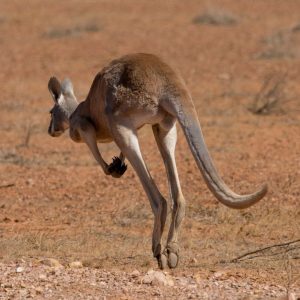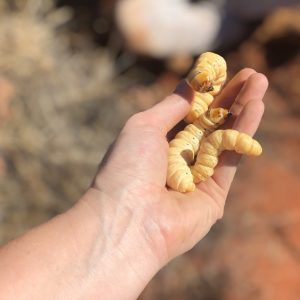Bush tucker is probably a familiar term to many, whether they be locals or travellers to the Australian outback. While there are a number of traditional foods in Australia, bush tucker remains the first, having provided sustenance to the Aboriginal people for thousands of years. Sadly, the settlement of non-indiginous peoples in Australia had a serious impact on Indigenous usage of bush foods – with their access affected by loss of lands and the consequences of agriculture – but many Indigenous Australians and Aboriginal people were still able to live off the land. These days, Aboriginal people continue to hunt and collect, with the experience used as a means of education along with personal needs and entertainment.
In recent years, bush tucker has become more readily embraced in non-indiginous Australian culture. The nutritional value of bush food has been acknowledged by non-indiginous Australians since the 1970s; native foods have consequently become more and more common in supermarkets. Kangaroo meat, for instance, has been sold since the 80s, while other traditional foods have been labelled as ‘gourmet’ and have established a place in a number of restaurants. This has led to an upswing in the cultivation of native food, and we imagine the industry will only continue to grow.
There is an extensive range of native foods still gathered, consumed and valued by the Aboriginal people. It is possible you might know some of them – witchetty grubs are fairly recognisable, for instance – but we wanted to highlight a few that you definitely should know more about. For the Anangu people, bush tucker is broken down into four groups, as follows.
Mai
Mai, pronounced may by the Anangu people, translates to ‘food from plants’. Examples of mai include the bush plum (arnguli), native fig (ili) and the quandong, known by the Anangu people as mangata. These fruits are a significant source of food for both the wildlife of Australia and traditional Aboriginal people, and may also be recognisable to non-indigenous people. The quandong, for instance, is one of the better known bush foods, and has been commercialised throughout Australian culture, often found in jams or jellies, relishes and even ice cream. Aside from being a traditional food, quandongs have also been used by the Anangu people to condition their hair or for medicinal purposes.
Other examples of mai include seeds from plants such as woollybutt grass (wangunu), and vegetables like the bush onion, otherwise known as tjanmata. Interestingly, tjanmata shares no relation with the common onion that we are all familiar with, is reported to taste ‘nutty’ and can be eaten raw or cooked. Seeds can also be eaten as they are, or ground to make flour, food paste (latja), or nyuma, known also as seed cakes.
Tjuratja

Tjuratja, pronounced joo-rrat-ja, are sweet nectar or foods. Although they’re a little different from the types of sweets we might find down the confectionery aisle, they are nevertheless just as delicious.
There are a few different types of tjuratja enjoyed by indigenous Australians. Honey ants (tjala), for example, are a delicacy, though they can be difficult to catch given they reside deep underground in their nests. While it therefore takes a fair amount of skill to snare one, knowing that their underground nests are often found beneath the mulga tree (wanari) might make discovering them a little easier. Luckily, mulga trees are incredibly common in Australia, and there is no shortage of them in Uluru-Kata Tjuta National Park. The honey-like syrup comes from the abdomen of the tjala, which you put in your mouth while holding the ants body.
Anangu people also enjoy tjuratja from various flora, like some species of mintjingka (native fuschia) which blossom after rain, or the yellow flowers of the honeysuckle grevillea (kaliny-kalinpa). While nectar can be drunk directly from the flowers, steeping them in water also results in a naturally sweet and delicious drink similar to cordial. If you are interested in seeing the kaliny-kalinpa, be sure to visit during the winter or spring, as that is when they flower.
If you would like to see some of these beautiful flora in person, we invite you to consider one of our tours to Uluru-Kata Tjuta National Park.
Kuka

Kuka, pronounced kooka, is a type of bush food you are probably familiar with – you may even have spotted some wandering or hopping on the side of the road. As you may have guessed, it translates to meat or edible animals. These include the woma python (kuniya), sand goanna (tinka), emu (kalaya) and kangaroo (maḻu). Traditionally, kuka was hunted by men and cooked over open fires. Eggs from lizards and birds are also categorised as kuka.
Kangaroo meat, as mentioned, has become a staple in Australian supermarkets, and remains a source of nutrition for Aboriginal people. As a low-fat meat that is high in protein, it is also good for you and is said to have a number of health benefits. However, be mindful when cooking it for the first time, as the lack of fat in the meat means it needs to be cooked differently to other red meats. Generally, it is slow cooked or used in stir-fry. Parts of the maḻu were also utilised by the Anangu to create spears ( kuḻaṯa) that they then used for hunting.
Emu meat is another important sustenance for Aboriginal people. It is low-fat, like kangaroo meat, although it hasn’t become commercialised like the latter. What fat the emu does have is traditionally used as bush medicine, or to oil wooden tools and utensils.
Maku

Maku, pronounced mah-koo, translates to edible grubs, the most famous of which is the witchetty grub. Found primarily in the roots of the witchetty bush – hence the name – witchetty grubs are larvae that can grow to at least six centimetres, and source their own food from the wood they reside in.
Although you might be a little put off at the thought of eating a grub, they are absolutely worth a try. Aboriginal people have enjoyed them for thousands of years, and while they can be eaten alive and raw, you can also lightly roast or barbeque them; it is said that they taste like chicken or prawns when cooked, while raw their taste resembles that of almonds. Like other bush foods already mentioned, witchetty grubs are nutritious and full of protein, making for a healthy and delicious meal.
Witchetty grubs have an important history within Aboriginal culture. They are common in Aboriginal paintings, and also used for medicinal purposes, with the grubs being turned into paste and used as a balm for burns. Traditionally, the Anangu women and children were responsible for finding the grub, using their knowledge of the flora to figure out where to dig. If you are interested in encountering these famous grubs, they are usually most active in the summertime.
You can also join us on our exclusive SEIT Patji Cultural tour, where you’ll have a chance to learn more about maku and other traditional flora and fauna used by the Anangu people as bush tucker.
